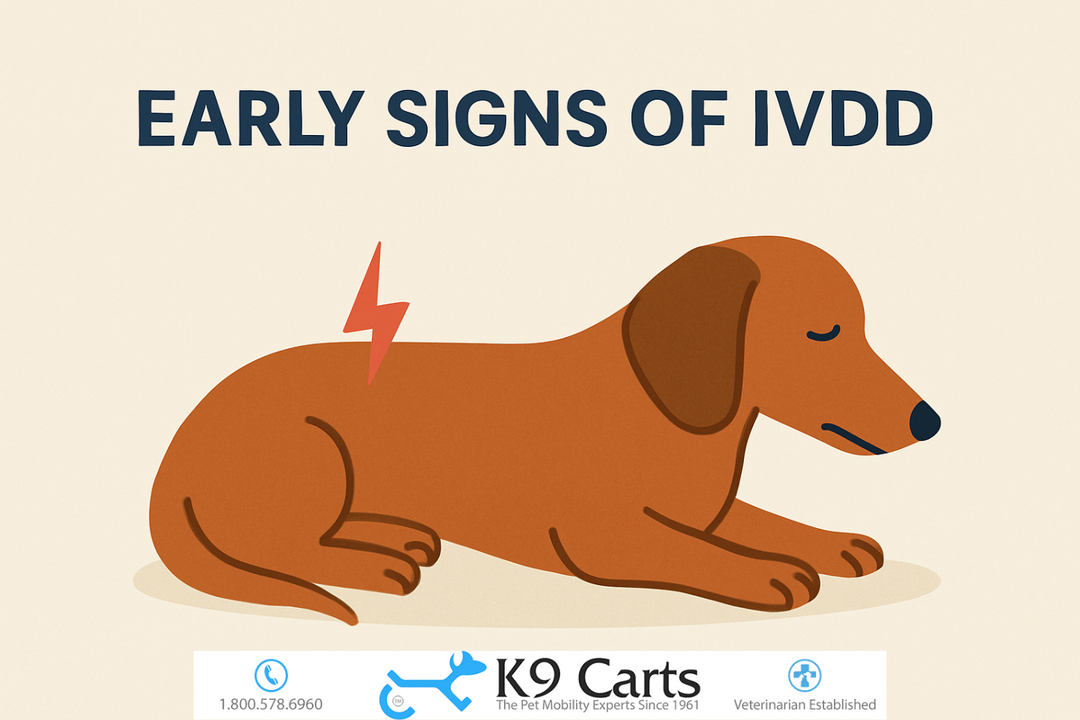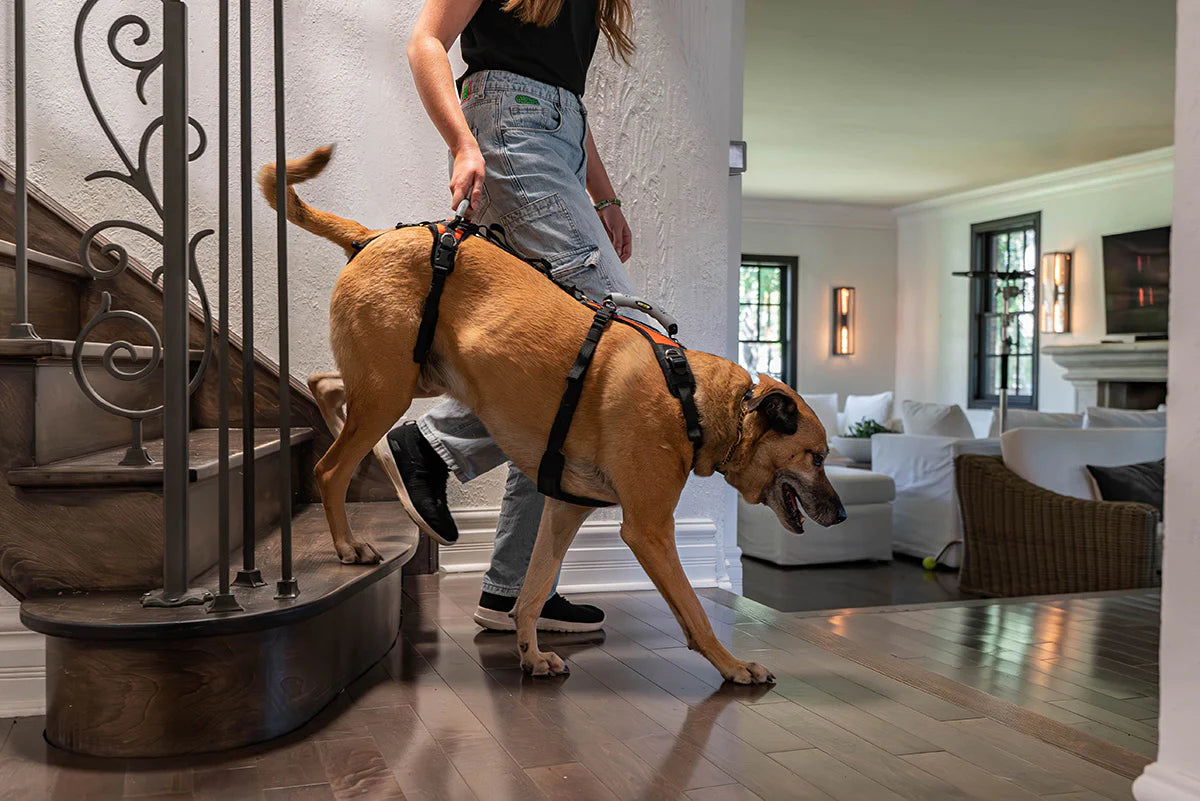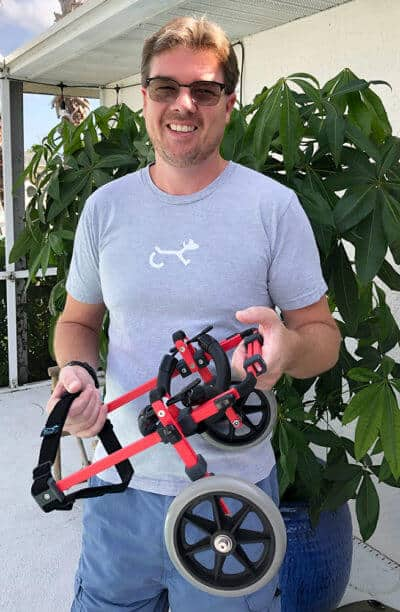What Are Early Signs of IVDD in Dogs? First Symptoms & Action Steps

Intervertebral Disc Disease, or IVDD, is one of the most common spinal conditions seen in dogs, particularly in breeds with long backs and short legs. This condition affects the discs that cushion the bones of the spine. When these discs become damaged or slip out of place, they can press on the spinal cord and cause pain, nerve damage, or even paralysis.
Catching IVDD early can make a big difference in how well your dog recovers. Whether you’re a pet parent managing a high-risk breed or you’ve noticed your dog acting a little "off," knowing the early warning signs and what to do next is essential.
This page will guide you through the key first symptoms of IVDD, how to tell if your dog may be developing the condition, and the steps you should take right away.
What is IVDD and which dogs are at risk?
IVDD stands for Intervertebral Disc Disease. It happens when the discs between the vertebrae of a dog’s spine begin to degenerate. This can lead to a disc slipping, bulging, or rupturing, which puts pressure on the spinal cord.
There are two main types of IVDD:
-
Type I IVDD: Sudden disc rupture, often seen in chondrodystrophic breeds (those with short legs and long backs).
-
Type II IVDD: Slower disc degeneration over time, more common in older or larger dogs.
Breeds most at risk for IVDD
Some dogs are much more likely to develop IVDD than others. The following breeds are considered high risk:
-
Dachshunds
-
Beagles
-
Cocker Spaniels
-
French Bulldogs
-
Shih Tzus
-
Pekingese
-
Basset Hounds
-
Lhasa Apsos
That said, IVDD can affect any dog, regardless of breed or size. Age, weight, and activity level can also contribute to the risk.
What are the earliest signs of IVDD in dogs?
IVDD symptoms can start off very mild and are often mistaken for minor aches or aging. However, spotting the condition in its early stages can help prevent more serious damage.
1. Reluctance to move or jump
One of the earliest signs is a sudden hesitation to perform activities your dog usually enjoys. This might include:
-
Avoiding stairs or furniture
-
Not wanting to go on walks
-
Hesitation when getting in or out of the car
If your dog is acting stiff or cautious, it’s important to pay close attention.
2. Arched back or neck stiffness
Dogs with spinal discomfort will often arch their back or lower their head and neck. This posture helps relieve pressure on the spine. You might notice:
-
A hunched back when walking or standing
-
Neck stiffness, avoiding turning the head
-
Crying or whining when touched in certain areas
3. Sensitivity to touch
A dog developing IVDD may react when you try to pet or lift them. This could include:
-
Flinching or whining when touched along the spine
-
Tensing up during handling
-
Growling or snapping unexpectedly
These reactions often indicate pain in the back or neck area.
4. Loss of coordination or weakness
As the spinal cord becomes compressed, messages from the brain may not reach the limbs properly. Early signs include:
-
Wobbly or unsteady walking (especially in the rear legs)
-
Dragging one or both back legs
-
Difficulty standing up after lying down
These changes can be subtle at first, but they typically progress if left untreated.
5. Behavior changes
Pain can affect your dog’s mood. Watch for:
-
Sudden withdrawal or hiding
-
Increased anxiety or restlessness
-
Decreased appetite
If your dog seems "not themselves," and any of the above physical signs are present, IVDD could be developing.
What should you do if your dog shows early signs of IVDD?
IVDD is a medical emergency when not treated quickly. Even mild signs should be taken seriously. If you suspect your dog may be showing early symptoms:
1. Restrict movement immediately
Limit your dog’s activity as much as possible. Keep them confined to a small area where they can rest and avoid jumping or running. Using a crate can help keep them safe.
Avoid letting your dog climb stairs, jump on or off furniture, or engage in any physical exertion until they’ve been evaluated by a veterinarian.
2. Schedule a veterinary visit right away
Call your veterinarian and explain the symptoms clearly. Early imaging, such as an X-ray or MRI, may be needed to diagnose the severity of the disc issue.
Prompt diagnosis can prevent worsening symptoms, including permanent paralysis.
3. Consider early conservative treatment
If caught early, many dogs with IVDD respond well to non-surgical treatment. This often includes:
-
Strict crate rest for 4 to 6 weeks
-
Pain management medications
-
Anti-inflammatory medications
-
Physical therapy (if recommended by your vet)
Early intervention gives your dog the best chance at recovery without surgery.
When is surgery needed for IVDD?
Not all dogs with IVDD need surgery. However, if your dog shows any of the following signs, surgery may be necessary:
-
Sudden paralysis in one or more limbs
-
Loss of bladder or bowel control
-
No response to pain in the toes or tail
-
Worsening symptoms despite rest and medication
Surgery aims to remove the material pressing on the spinal cord and restore function. Recovery outcomes can vary depending on how early the problem is caught.
What happens after diagnosis? Long-term care and mobility support
Once your dog has been diagnosed with IVDD, long-term management becomes essential. Whether your dog has had surgery or is recovering with conservative treatment, maintaining spinal safety is key.
Mobility aids and home care
If your dog has limited use of their back legs, mobility support can make a big difference. Tools such as custom-built dog wheelchairs allow dogs with IVDD to remain active and independent while protecting their spine.
At K9 Carts, we design lightweight, vet-approved dog wheelchairs that support the rear limbs while allowing for full upper body movement. Each chair is built to the exact size and condition of your dog, giving them stability without adding strain.
Other long-term strategies include:
-
Weight management to reduce pressure on the spine
-
Avoiding slippery floors by using rugs or dog socks
-
Ramps instead of stairs
-
Regular check-ups with your vet
What is the outlook for dogs with IVDD?
The outcome for dogs with IVDD depends on how early the condition is caught and treated. Many dogs recover fully or regain enough mobility to lead comfortable lives.
Dogs who have experienced partial or full paralysis can still enjoy a high quality of life with the right care. Custom wheelchairs, physical therapy, and proper home management allow them to move, play, and interact just like before.
Recovery takes time and consistency, but many dogs go on to live happily and pain-free.
Helping your dog stay happy and mobile
Recognizing IVDD in its early stages is one of the most important things you can do to protect your dog’s health. From the first signs of hesitation to jump, to changes in posture or coordination, early action can mean the difference between full recovery and long-term damage.
If your dog does require mobility support, remember that there are effective solutions available. K9 Carts has been helping dogs with IVDD and other mobility issues stay active and independent for decades. With the right equipment, treatment, and care, your dog can still enjoy a full and active life.
By staying alert to early signs and acting quickly, you're giving your dog the best chance at a comfortable and mobile future.
Frequently asked questions
What are the first signs of IVDD in dogs?
The first signs of IVDD in dogs are often subtle and easy to overlook. These can include reluctance to jump, stiffness in the neck or back, changes in posture, and sensitivity to touch along the spine. Dogs may also become less active, show signs of pain when picked up, or hesitate when using stairs. As the condition progresses, symptoms like weakness in the hind legs or wobbling may appear. Early recognition and restricted movement are key to preventing further injury.
How do I know if my dog has a slipped disc or just muscle pain?
To tell the difference between a slipped disc (IVDD) and muscle pain in dogs, look for signs of nerve involvement. IVDD often causes coordination issues, weakness, or knuckling in the paws, especially in the back legs. Muscle strain typically doesn’t cause neurological problems like loss of balance or limb dragging. If your dog is showing changes in movement, posture, or reactions to touch along the spine, it’s safest to assume a disc problem and seek veterinary care.
Can a dog recover from IVDD without surgery?
Yes, many dogs with mild to moderate IVDD can recover without surgery using conservative treatment. This usually includes crate rest for several weeks, pain and anti-inflammatory medications, and sometimes physical therapy. However, recovery depends on early diagnosis and strict rest. Dogs with severe neurological symptoms or paralysis may not respond to conservative care and may need surgery for the best outcome.
What should I do immediately if I think my dog has IVDD?
If you think your dog may have IVDD, the first thing to do is restrict their movement. Do not allow them to jump, run, or climb stairs. Confine them to a small, padded space or crate and limit all physical activity. Then, call your veterinarian as soon as possible. Quick action can prevent worsening of symptoms and reduce the risk of permanent damage or paralysis.
How long does IVDD recovery take in dogs?
Recovery time for IVDD in dogs depends on the severity of the condition and the type of treatment. Dogs recovering with conservative treatment usually need at least 4 to 6 weeks of strict crate rest. Post-surgery recovery can take 6 to 12 weeks or longer, depending on the dog’s mobility before the procedure. Physical therapy, proper home care, and mobility aids can support a smoother and faster recovery process.
What are the signs that IVDD is getting worse?
Signs that IVDD is progressing include increased weakness in the limbs, wobbling or staggering, dragging of the back legs, and loss of bladder or bowel control. Your dog may also show signs of severe pain such as constant crying, panting, or refusing to move. If you notice any of these symptoms, especially sudden paralysis, it’s an emergency and requires immediate veterinary attention.
How can a dog wheelchair help with IVDD recovery or mobility?
A dog wheelchair can help dogs with IVDD by supporting their back end when hind limb mobility is compromised. It keeps the spine aligned, reduces strain, and allows the dog to move safely without risking further injury. For dogs with partial or full rear paralysis, a well-fitted wheelchair allows continued activity and independence. It also helps maintain muscle tone and bladder/bowel function through regular movement.
Tip: Choose a custom-built wheelchair like those from K9 Carts to ensure proper fit and spinal support for IVDD cases.
Is IVDD in dogs painful?
Yes, IVDD can be very painful, especially in the early stages or during a disc rupture. Dogs may whine, cry, pant excessively, or avoid being touched. Pain can be localized to the neck or back and may worsen with movement. Pain management is a critical part of treatment, both in conservative care and post-surgery. Unmanaged pain can also lead to behavioral changes like aggression or withdrawal.
Can IVDD come back after recovery?
Yes, dogs who have had IVDD are at risk of future episodes. Even after successful treatment or surgery, the spine remains vulnerable. Additional discs may degenerate over time. Preventive steps such as avoiding jumping, maintaining a healthy weight, and using ramps instead of stairs can help reduce the chance of recurrence. Monitoring for early signs is also important in catching future flare-ups early.
How can I prevent IVDD in high-risk dog breeds?
While IVDD cannot always be prevented, there are ways to reduce the risk, especially in breeds prone to spinal issues. Limit high-impact activities like jumping and stair climbing. Keep your dog at a healthy weight to avoid extra stress on the spine. Use ramps for furniture access and avoid letting your dog leap onto hard surfaces. Regular vet check-ups can help monitor spinal health before symptoms appear.
References
-
https://www.vetmed.ucdavis.edu/hospital/animal-health-topics/disc-disease
-
https://cgejournal.biomedcentral.com/articles/10.1186/s40575-016-0039-8
-
https://avmajournals.avma.org/view/journals/javma/263/5/javma.24.08.0553.xml
-
https://www.frontiersin.org/journals/veterinary-science/articles/10.3389/fvets.2020.596059/full








